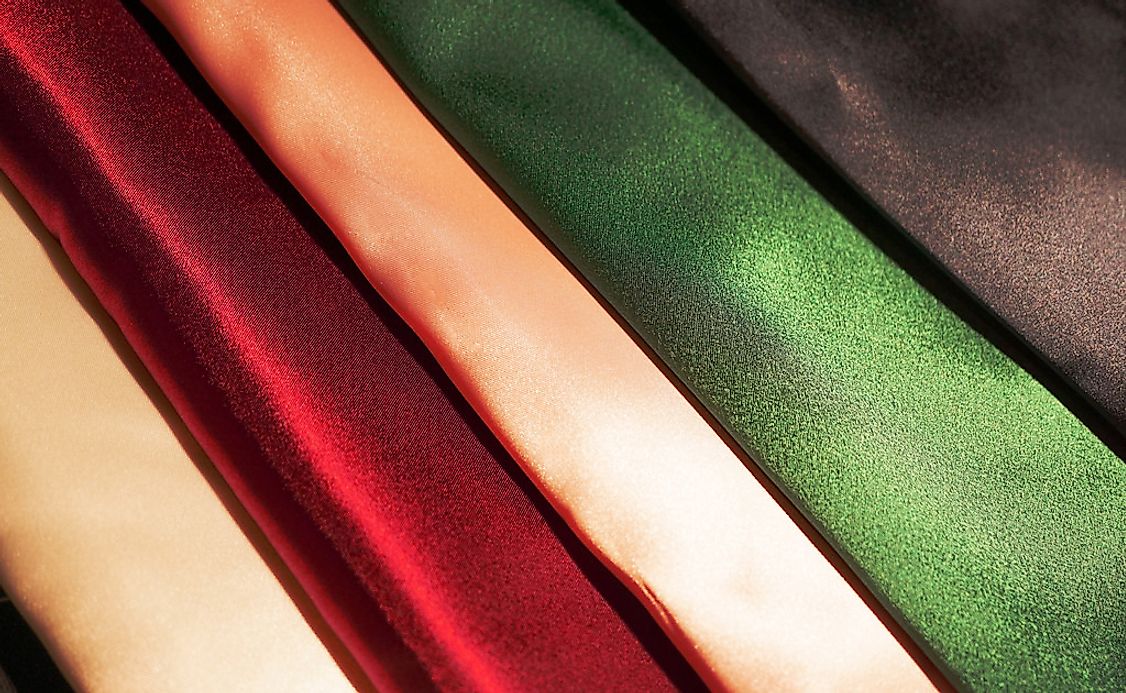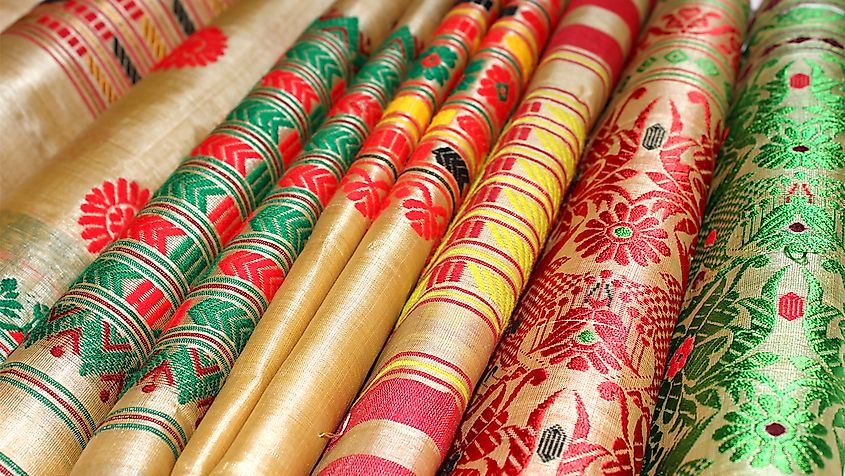How Many Types Of Silk Are There?

Silk exudes elegance and sophistication by its shine and opulence. It has several attributes which set it above other fibers. Silk is both softer than human hair but as strong as wire. It is resistant to dust and moths. Silk has been used for thousands of years dating back to Indus Valley Civilization which was present around 2500 BCE. Silk is a natural protein fiber produced by silkworms that are kept in captivity. Other insects can also produce silk. However, only silk from the silkworms is used for textile purposes. China is the largest silk producer and consumer in the world followed by India where Indian sarees made from silk are famous. There are several types of silk commercially known and produced around the world. Some of the common types of silks include;
Mulberry Silk
Mulberry silk is the most common and widely used silk around the world. It accounts for about 90% of the world’s supply. Thus, the term “silk” generally refers to the silk from a mulberry worm. This type of silk is produced by the Bombyx mori silkworms who feed on mulberry bushes. hence the name. The silkworms are entirely domesticated and reared indoors. Mulberry silk is popular around the world, though especially in China, Japan, and Korea. The production of the silk involves the killing of the worms in their cocoons to extract the silk fiber. The disadvantage of using mulberry silk is that it requires extra care to maintain its smooth texture.
Tasar Silk
Tasar or tussah silk is a type of wild silk produced by caterpillars other than the mulberry worm. The silk has a feel and quality different from the mulberry silk. It is produced from a Tasar silkworm which belongs to the genus Antheraea. The Chinese Tasar silkworm produces the largest quantity of non-mulberry silk followed by the Indian Tasar silkworm. The Japanese Tasar silkworm produces a green silk thread. Most of the Tasar silks are copperish in color and are mainly used in furnishing and interior since they are the strongest fibers in the world. Tasar silk is produced by reeling the cocoons of the Tasar silkworm. This silk is available in its natural form since it is tough to dye.
Eri Silk
Eri silk, also known as the Endi or Errandi silk, is creamy white-colored silk. It is derived from two domesticated species of silkworms known as Samia ricini and Philosamia ricini. Eri silk is a peace silk since it is spun from the cocoon of the silkworm without destroying the worm unlike mulberry and Tasar silk. The castor silkworm which produces Eri silk is reared on the castor oil plant. The silk has a matt appearance of wool or cotton. The castor silkworm and the mulberry silkworm are the only domesticated silkworms with both relying on human intervention to develop. Eri silk is durable and makes great material for clothing and soft furnishing such as curtains. However, the silk is heavy to wash and may harbor microorganisms since it is easier for them to stick to the fabric.

Muga Silk
Muga silk is golden yellow in color. The Muga silkworm also belongs to the same genus as the Tasar silkworm. The silkworm is semi-domesticated, especially in Assam and feeds on aromatic leaves of soalu plants. Muga silk is known for its glossy texture and its golden brown color. The silk is limited in supply and is only used in the state of Assam for making traditional dresses, especially for the royal families. Its high quality makes it popular for making sarees and chaddars. Mass production of Muga silk is possible since its production is eco-friendly and the silkworm does not require delicate care. The porosity of the Muga silk can sometimes be a disadvantage as it sometimes limits bleaching.
Spider Silk
Spider silk is a non-insect silk variety that is soft and fine in texture. It is the most difficult silk to produce as spiders cannot be bred like silkworms and do not produce as much yarn as silkworms. Spider silk is produced from Madagascan species including Nephila madagascarensis. The accumulated fiber is reeled from the abdominal segment four or five times a month. The cost of producing this silk is so high that it is not used in the textile industry. However, it is one of the most durable types of silk used in the production of bulletproof vests, telescopes, optical instruments, and wear-resistant clothes.
Mussel Silk
Mussel silk is obtained from bivalve found in shallow waters along the shores of the Italia and Dalmatia of Adriatic. It is often called the ‘sea silk’ since it is produced by mussels found on the seabed. The brown filament is produced by the mussel to anchor it to rock. The filament is combed and spun into silk referred to as fish silk. The production of mussel silk is confined to the shores of Taranto, Italy. The effects of pollution have made it difficult to source the silk. It accounts for one of the most expensive types of silk. However, this silk has been produced since Ancient Greece, around the 8th century BCE.
Anaphe Silk
Anaphe silk is commonly produced in the southern and central African countries. It is produced from a silkworm in the genus Anaphe which spin cocoons in communes enclosed by a thin layer of silk. The fluff is spun into a raw silk that is normally soft and lustrous. The fabric made out of Anaphe silk is elastic and stronger than the mulberry silk. The silk is used in making velvet, light seat covers, and plush.
Coan Silk
Coan silk is produced from the larvae of the Pachypasa atus which is common in the Mediterranean region covering Italy, Greece, and Turkey. The species feed exclusively on trees such as pines, oak, and juniper and spin white cocoons. Coan silk was used to make crimson-dyed clothes which were worn by dignitaries in ancient times, especially in Rome. The silk is no longer produced commercially due to the limited output and the emergence of the superior variety of silk. However, it can be mixed with other varieties of silk to produce a stronger and durable fabric.











